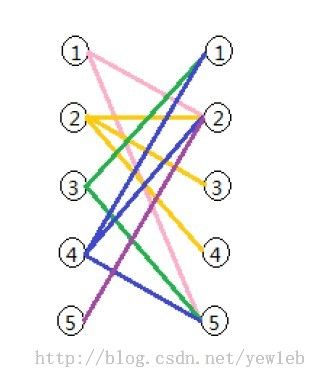USCAO4.2 The Perfect Stall ,二分图最大匹配
题目地址:http://poj.org/problem?id=1274
题意:给你n 头牛,和m 个墙,每头牛有自己喜欢的墙,要求每堵墙只能有一头牛,求最多的匹配数。
分析:二分图的最大匹配
sample_input
5 5
2 2 5
3 2 3 4
2 1 5
3 1 2 5
1 2
sample_output
4
如下构成二分图,我们可以直接采用匈牙利算法。
给上图添加源点和汇点,就构成了网络流。把图构好后,就可以直接上模板了。
Code:
#include <cstdio>
#include <cstring>
#include <queue>
#include <vector>
#include <algorithm>
using namespace std;
const int maxn = 400 + 10;
const int INF = 1000000000;
struct Edge {
int form, to, cap, flow;
};
struct Dinic {
int n, m, s, t;
vector<Edge> edges; //边表.edges[e]和edges[e^1]互为反向弧
vector<int> G[maxn*maxn]; //邻接表,G[i][j]表示结点i的第j条边在e数组中的序号
bool vis[maxn]; //BFS使用
int d[maxn]; //从起点到i的距离
int cur[maxn]; //当前弧指针
void init(int n) {
this->n = n;
for (int i = 0; i <=n; i++) G[i].clear();
edges.clear();
}
void AddEdge(int from, int to, int cap) {
edges.push_back((Edge) {from, to, cap, 0});
edges.push_back((Edge) {to, from, 0, 0});
m = edges.size();
G[from].push_back(m - 2);
G[to].push_back(m - 1);
}
bool BFS() {//使用BFS计算出每一个点在残量网络中到t的最短距离d.
memset(vis, 0, sizeof(vis));
queue<int> Q;
Q.push(s);
vis[s] = 1;
d[s] = 0;
while (!Q.empty()) {
int x = Q.front(); Q.pop();
for (int i = 0; i < G[x].size(); i++) {
Edge& e = edges[G[x][i]];
if (!vis[e.to] && e.cap > e.flow) { //只考虑残量网络中的弧
vis[e.to] = 1;
d[e.to] = d[x] + 1;
Q.push(e.to);
}
}
}
return vis[t];
}
int DFS(int x, int a) {//使用DFS从S出发,沿着d值严格递减的顺序进行多路增广。
if (x == t || a == 0) return a;
int flow = 0, f;
for (int& i = cur[x]; i < G[x].size(); i++) {
Edge& e = edges[G[x][i]];
if (d[x] + 1 == d[e.to] && (f = DFS(e.to, min(a, e.cap - e.flow))) > 0) {
e.flow += f;
edges[G[x][i] ^ 1].flow -= f;
flow += f;
a -= f;
if (a == 0) break;
}
}
return flow;
}
int Maxflow(int s, int t) {
this->s = s; this->t = t;
int flow = 0;
while (BFS()) {
memset(cur, 0, sizeof(cur));
flow += DFS(s, INF);
}
return flow;
}
};
Dinic g;
int n, m, s, t;
void make_graph() {
int u, c, v;
s = 0; t = n + m + 1;
g.init(t);
for (u = 1; u <= n; u++) {
scanf("%d", &c);
while (c--) {
scanf("%d", &v);
g.AddEdge(u, v + n, 1);
}
}
for (u = 1; u <= n; u++) g.AddEdge(s, u, 1);
for (u = 1; u <= m; u++) g.AddEdge(u + n, t, 1);
}
int main() {
while (~scanf("%d%d", &n, &m)) {
make_graph();
int answer = g.Maxflow(s, t);
printf("%d\n", answer);
}
return 0;
}
